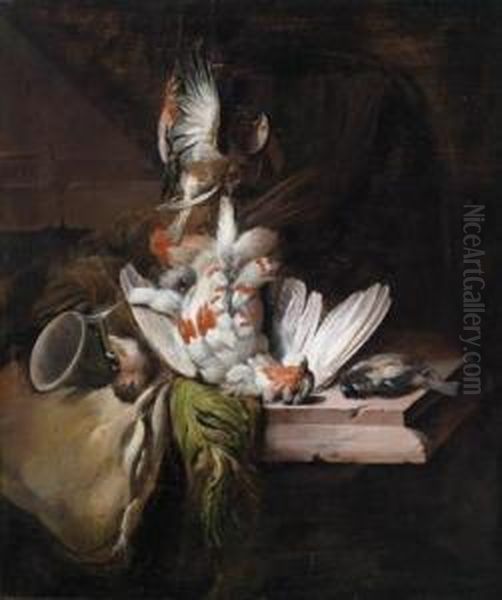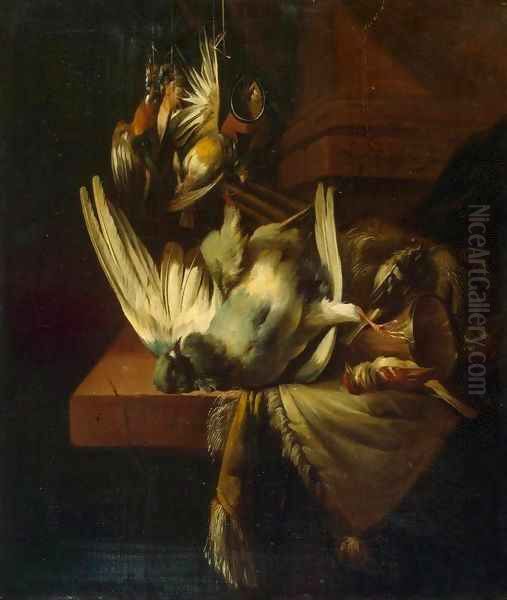William Gowe Ferguson stands as a fascinating figure in 17th-century art history, a Scottish painter whose career and style became deeply intertwined with the flourishing artistic traditions of the Netherlands during its Golden Age. Known primarily for his meticulously rendered still lifes, particularly those featuring dead game and hunting paraphernalia, Ferguson navigated the cultural and artistic landscapes of Britain and the Continent, leaving behind a body of work admired for its technical skill and adherence to Dutch aesthetics. His life, spanning from approximately 1632 to 1695, saw him travel extensively, absorbing influences and establishing a reputation that persists in major museum collections today.
Origins and Continental Journeys
Born in Scotland around 1632 or 1633, William Gowe Ferguson's early life remains somewhat obscure, as is common for many artists of this period. What is clear is that his artistic ambitions led him away from his homeland towards the vibrant art centres of mainland Europe. The Netherlands, then experiencing its Golden Age of painting, was a powerful magnet for artists seeking training and patronage. Ferguson is documented as being active in Utrecht between 1648 and 1651, placing him in a city renowned for its Caravaggisti tradition but also developing its own distinct schools of painting, including still life.
His travels did not end there. Records indicate his presence in Amsterdam between 1660 and 1668. Amsterdam was the bustling commercial and artistic heart of the Dutch Republic, home to masters like Rembrandt van Rijn and a thriving market for various painting genres. Ferguson also spent time in The Hague, another significant artistic centre, particularly known for its elegant courtly life and associated patronage. His journeys may have extended further, with sources suggesting visits to Italy and France, and possibly periods spent working in London.

This itinerant lifestyle was crucial to Ferguson's development. It exposed him to a wide range of artistic styles, techniques, and subject matter. While born Scottish, his artistic identity was forged primarily on the Continent, particularly through his immersion in the Dutch art world. He eventually appears to have settled back in the Netherlands, reportedly residing in Arnhem from 1681 onwards, suggesting a lasting connection to the country that so profoundly shaped his art. His death is generally accepted as occurring around 1695.
Artistic Style: The Dutch Influence
Ferguson's artistic output is dominated by still life, specifically the subgenre known as nature morte or 'dead nature'. His preferred subjects were arrangements of dead game birds – partridges, pheasants, songbirds – often accompanied by hunting equipment like firearms, powder horns, nets, and game bags. These compositions are typically set against neutral, often dark backgrounds, or sometimes within architectural niches or against stone ledges draped with fabric, enhancing the sense of depth and focusing attention on the meticulously rendered objects.
The overwhelming influence on Ferguson's style comes from Dutch still-life painting. Art historians consistently point to the impact of artists like Willem van Aelst (1627–c. 1683), a leading master of elegant still lifes, known for his sophisticated compositions, rich colours, and exquisite rendering of textures, particularly velvet and metal. Van Aelst worked in France and Italy before settling in Amsterdam, and his refined style clearly resonated with Ferguson. Another cited influence is Jan Vonck (c. 1631–after 1664), a Dutch painter also known for his depictions of dead birds and fish.
Ferguson absorbed the Dutch preoccupation with realism and detail. His paintings exhibit a remarkable ability to capture the varied textures of his subjects: the softness of feathers, the cold gleam of metal, the rough weave of a hunting bag, the smooth surface of stone. He employed a controlled application of paint and a sophisticated understanding of light and shadow (chiaroscuro) to model forms and create a convincing illusion of three-dimensionality. His palette, while often favouring earthy tones appropriate to the subject matter, could also incorporate richer colours in fabrics or the plumage of certain birds.
The Niche Composition and Contemporaries
A distinctive feature found in some of Ferguson's works is the use of a painted architectural niche or alcove as a setting for his still-life arrangements. This trompe-l'oeil device, popular among some Dutch painters, creates an enhanced sense of depth and frames the objects within a defined space. Interestingly, this compositional strategy was also employed by other still-life painters active in The Hague during the period Ferguson is known to have worked there.

Artists like Cornelis Lelienbergh (c. 1626–after 1676) and Hendrick de Fromantiou (c. 1633–after 1693) are noted contemporaries who also specialized in game pieces and sometimes utilized similar niche settings. While direct collaboration isn't documented, their shared presence in The Hague's artistic milieu suggests a potential exchange of ideas or a common response to prevailing tastes. Hendrick de Fromantiou, notably, had connections to the circle of Rembrandt van Rijn (1606-1669) and was also involved in the art trade, famously helping expose counterfeit paintings sold by the dealer Gerrit van Uylenburgh (c. 1625–1679).
Ferguson's adoption of the niche motif, while not unique to him, demonstrates his engagement with specific trends within the Dutch still-life tradition. It highlights his ability to adapt and integrate fashionable compositional devices into his own work, aligning himself with sophisticated tastes prevalent in centres like The Hague.
Representative Works and Themes
Several key works exemplify William Gowe Ferguson's style and thematic concerns. The Rijksmuseum in Amsterdam holds notable examples, including paintings titled Uccelli morti (Dead Birds) and Gallo (Rooster/Game Bird), both dated 1684. These works showcase his characteristic subject matter and meticulous technique. Another significant piece, Gallo, selvaggina e attrezzi da caccia (Rooster, Game, and Hunting Equipment), can be found in the Louvre Museum in Paris.
The National Galleries of Scotland in Edinburgh holds important works, reflecting his Scottish origins despite his continental career. Still Life with White Cockerel and Dead Game is a prime example, displaying a complex arrangement of birds and hunting gear against a dark background, highlighting his skill in composition and texture. Another work often cited is simply titled Natura morta (Still Life), also in Edinburgh. Auction records also mention works like Dead Game, indicating the continued presence of his paintings in the art market.
The themes explored in Ferguson's work are typical of 17th-century still life. The depiction of dead game often carried connotations of vanitas – reminders of the transience of life and the inevitability of death. Simultaneously, hunting was an aristocratic pursuit, and paintings of game could signify wealth, status, and the bounty of nature or the larder. The inclusion of hunting implements further grounds the paintings in this specific activity. Ferguson's detailed realism aligns with the era's growing interest in empirical observation, even when applied to seemingly straightforward subjects like dead animals.
Ferguson in the Wider Artistic Context
Placing Ferguson within the broader art historical landscape requires considering both the Dutch and British contexts. In the Netherlands, he operated within an incredibly rich and specialized tradition of still-life painting. While influenced by Van Aelst and Vonck, his work can also be seen alongside that of other prominent game piece specialists like Jan Weenix (1642–1719) and Melchior d'Hondecoeter (1636–1695), who brought the genre to new heights of decorative grandeur, often creating large canvases for wealthy patrons' homes. Ferguson's work tends to be more restrained and intimate compared to the elaborate compositions of Weenix or Hondecoeter.
Compared to broader Dutch still-life masters like Willem Kalf (1619–1693), known for his opulent pronkstilleven (ostentatious still lifes), or Abraham van Beijeren (c. 1620–1690), famous for his lavish banquet pieces and seascapes, Ferguson maintained a tighter focus on the specific subgenre of dead game. His dedication to this theme allowed him to achieve a high degree of proficiency and recognition within that niche.
In the context of 17th-century British art, Ferguson is a more unusual figure. While Britain had its own artistic traditions, still life was not as dominant or highly regarded a genre as portraiture, which flourished under masters like Sir Peter Lely (1618–1680) and later Sir Godfrey Kneller (1646–1723), both of whom were foreign-born but dominated the English market. Ferguson's specialization and his strong adherence to a continental European style make him stand out. He is often cited as one of the most accomplished still-life painters of British origin during this period, precisely because his training and style were so deeply rooted in Dutch practice.
Patronage and Later Career
Evidence suggests Ferguson found patronage among the British aristocracy, despite spending much of his career abroad. A significant connection was with the Duke of Lauderdale, a powerful Scottish nobleman. Ferguson is recorded as having painted works for Ham House in London, a residence lavishly refurbished by the Duke and Duchess of Lauderdale in the 1670s. This commission indicates that his reputation reached influential circles back in Britain and that his Dutch-inflected style was appreciated by elite patrons.
Details about his later career after settling in Arnhem around 1681 are less plentiful. However, the works dated to the mid-1680s, such as those in the Rijksmuseum, demonstrate his continued activity and mastery of his chosen genre. He seems to have maintained his focus on meticulously rendered still lifes of game throughout his mature period. His death around 1695 marks the end of a career that successfully bridged the artistic worlds of Scotland and the Netherlands.
Legacy and Historical Assessment
William Gowe Ferguson is historically assessed as a significant, if specialized, figure in 17th-century European art. He holds a particular importance within Scottish art history as one of the nation's earliest painters to achieve recognition in the still-life genre, albeit by adopting a style developed elsewhere. His work serves as a prime example of the cross-cultural artistic exchanges that occurred frequently in early modern Europe, where artists travelled, trained, and worked across national borders.
His reputation rests on his technical proficiency – the convincing rendering of textures, the skillful manipulation of light, and the balanced composition of his arrangements. While perhaps not as innovative as some of his Dutch contemporaries, he mastered the conventions of the game piece genre and produced works of high quality and lasting appeal.
The presence of his paintings in major international collections like the Rijksmuseum, the Louvre, and the National Galleries of Scotland attests to his enduring significance. Collectors like Arthur Kay, who donated works to the Scottish national collection, played a role in ensuring his legacy. The continued appearance of his works at auction further indicates an ongoing appreciation for his refined, Dutch-inspired still lifes. He remains recognized as one of the foremost British exponents of still-life painting in his era.
Conclusion
William Gowe Ferguson's career exemplifies the fluid nature of artistic identity and influence in the 17th century. A Scotsman by birth, he became a master practitioner of a quintessentially Dutch genre, demonstrating how thoroughly artistic styles could transcend geographical boundaries. Through extensive travel and immersion in the continental art scene, particularly in the Netherlands, he honed a meticulous technique perfectly suited to the depiction of nature morte. His paintings of dead game and hunting attributes, influenced by masters like Willem van Aelst, remain compelling examples of the genre, admired for their realism, compositional harmony, and subtle thematic depth. Ferguson secured his place in art history as a skilled interpreter of the Dutch still-life tradition, leaving a legacy appreciated in both his native Scotland and the lands where he primarily practiced his art.